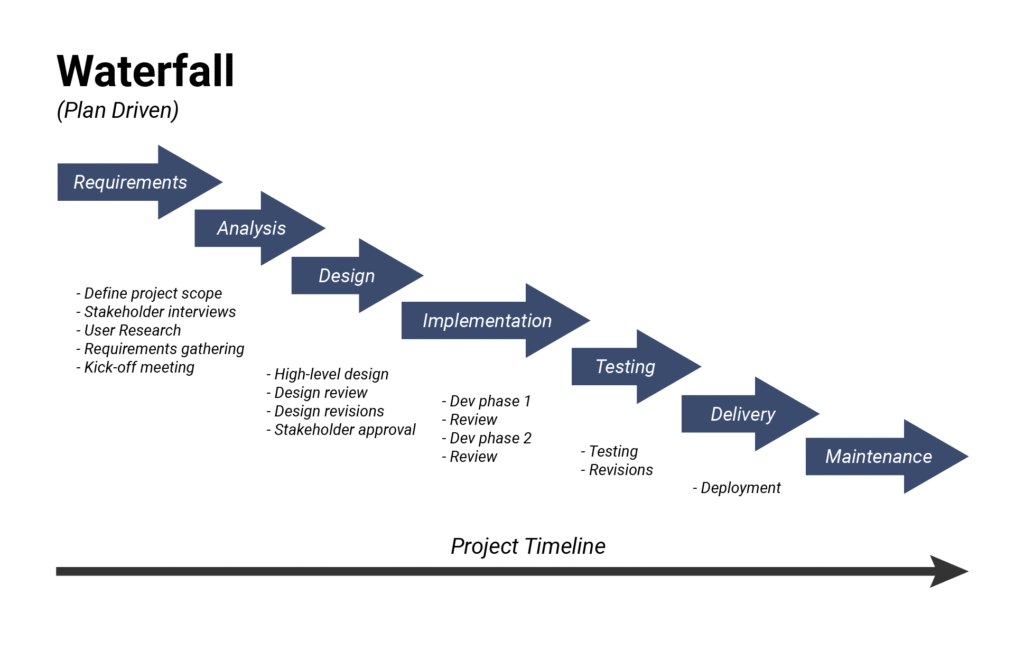What is the Waterfall Model?
The Waterfall Model is a sequential, linear approach to software development. In this model, the software development process flows steadily downwards through a series of distinct phases, like a waterfall. The core principle is that each phase must be 100% complete and its output approved before the next phase can begin. There is no overlapping or iterative cycling between phases.
It is one of the oldest and most straightforward SDLC models, rooted in traditional engineering disciplines.
The Phases of the Waterfall Model
The model is structured into the following sequential phases:
- Requirements Gathering & Analysis: This is the foundational phase. All possible requirements for the system to be developed are captured and documented in a Software Requirements Specification (SRS) document. This document acts as the contract for the entire project.
- System Design: Using the SRS, system architects and designers create the technical blueprint. This includes defining the overall system architecture, hardware and system requirements, and specifying how each component will work together. The output is a Design Document Specification (DDS).
- Implementation (Coding): Developers start writing code based on the DDS. The system is broken down into smaller units, and each unit is developed and tested individually (Unit Testing). This is the phase where the software is actually built.
- Testing: Once all units are developed and integrated, the entire system is tested as a whole against the requirements defined in the SRS. Quality Assurance (QA) teams perform integration, system, and user acceptance testing to identify and fix any bugs or defects.
- Deployment: After successful testing, the product is deployed to the production environment for the end-users to access and use.
- Maintenance: After deployment, the software enters the maintenance phase. This involves fixing any undiscovered bugs, providing ongoing support, and releasing updates or patches for performance improvement. This phase continues for the life of the software.
Key Characteristics
- Sequential & Phased: Each phase has a defined start and end point.
- Milestone Oriented: The output of one phase is the input for the next.
- Document-Driven: Heavy emphasis on comprehensive documentation at each stage (SRS, DDS, etc.).
- Inflexible: It is very difficult and expensive to go back and change requirements once a phase is completed.
A Practical Example: How Ngahtech.com Would Use the Waterfall Model
Let’s imagine a client approaches Ngahtech.com to develop a software system for generating annual tax compliance reports for a financial institution.
This project is a perfect fit for the Waterfall Model. Here’s why and how Ngahtech would execute it:
Why Waterfall is a Good Fit:
- Fixed Requirements: The requirements are based on government tax laws, which are clear, fixed, and unlikely to change during the project.
- Clear Deliverables: The final output is well-defined: a system that generates specific, compliant reports.
- Minimal Client Ambiguity: The client knows exactly what they need, and there is little room for “discovery” during development.
How Ngahtech.com Executes the Phases:
- Requirements Gathering:
- Ngahtech’s business analysts work with the client and tax experts.
- They produce a massive, detailed SRS document that lists every single input, calculation, output format, and compliance rule. The client signs off on this document, freezing the requirements.
- System Design:
- Based on the signed SRS, Ngahtech’s solution architects design the system.
- They decide on the database schema, the reporting engine, the user interface for data entry, and the security protocols. This is all documented in a Design Document (DDS). No code is written yet.
- Implementation:
- Developers at Ngahtech now start coding strictly according to the DDS. They build the data entry forms, the calculation logic for tax rules, and the report generators. This phase takes several months.
- Testing:
- After coding is complete, QA engineers test the entire system. They input sample financial data and verify that every calculation matches the tax laws defined in the original SRS. They check for bugs and ensure the reports are 100% accurate.
- Deployment:
- Once the system passes all tests, it is installed on the client’s servers. The client’s staff is trained on how to use it.
- Maintenance:
- Ngahtech provides a support contract. If a bug is found or if a tax law changes slightly next year, Ngahtech will make the necessary patches (a form of maintenance) under a new, smaller project scope.
Advantages and Disadvantages
| Advantages | Disadvantages |
|---|---|
| ✅ Simple and easy to understand. | ❌ Inflexible. Making changes is extremely costly and difficult once a phase is complete. |
| ✅ Disciplined and structured. | ❌ Late Working Model. The client only sees the final product at the very end, which is high-risk. |
| ✅ Clear milestones and deliverables. | ❌ High Uncertainty. If initial requirements are wrong, the entire project can fail. |
| ✅ Well-documented. | ❌ Not suitable for complex or object-oriented projects. |
| ✅ Works well for small, well-understood projects. | ❌ Poor fit for long-term or ongoing projects where requirements evolve. |
